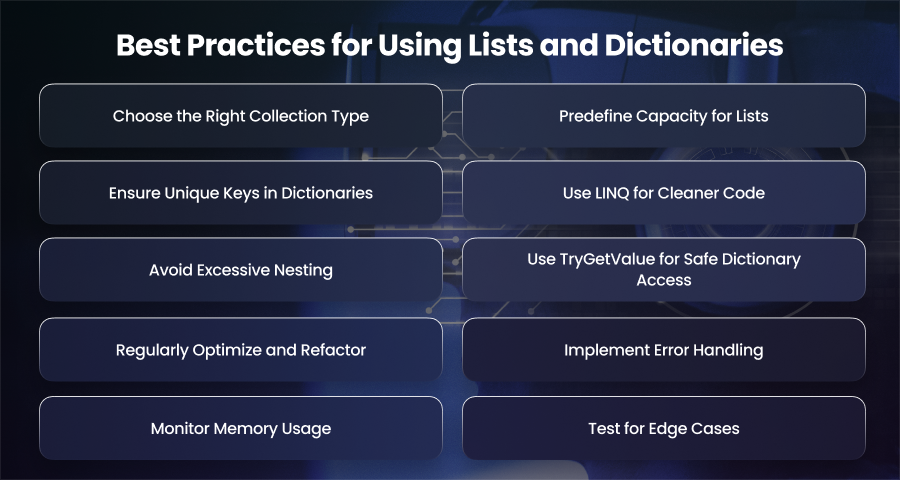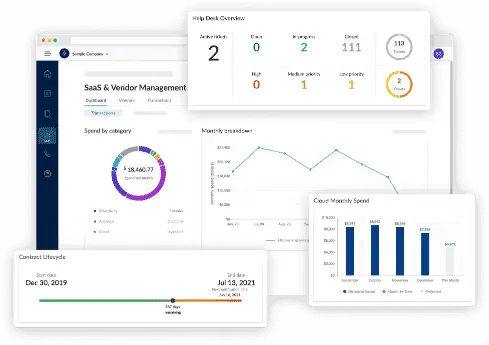Effective data management is crucial to creating scalable, high-performance systems in today’s software development, and with at least over 6 million C# developers, it’s not a surprise. Numerous features provided by C# collections are crucial for organizing and manipulating data. Two of the most commonly used generic collections in C# are Lists and Dictionaries. These structures allow developers to manage data flexibly while providing powerful methods for querying and updating elements.

This in-depth guide explores the fundamentals, advanced operations, and best practices for using Lists and Dictionaries, empowering you to write clean, efficient, and scalable code.
C# Collections: An Overview
Data structures called collections in C# let you store, retrieve, and work with sets of items. The System includes them.System and Collections.collections.generic namespaces. Although both namespaces offer a range of collection types, current development prefers the generic versions (List, Dictionary, etc.) because they provide:
- Type Safety: Enforces compile-time type verification to prevent runtime type mistakes.
- Better Performance: Eliminates boxing and unboxing for value types.
- Flexibility: Supports various operations and can dynamically resize.
By choosing the appropriate collection, you can optimize the performance and clarity of your code, or you can hire C# developers to ensure top-tier quality. Let’s explore Lists and Dictionaries, two versatile tools for handling ordered and key-based data.
Lists in C#: The Basics
A List<T> is a dynamic array capable of storing elements of a specific type. It provides flexibility by automatically resizing as elements are added or removed, making it a powerful alternative to arrays.
Features of List<T>
- Dynamic Resizing: Lists automatically expand or shrink as required.
- Indexed Access: Elements can be accessed using zero-based indices.
- Rich API: Offers methods for adding, removing, and searching for elements.
Use Cases for List<T>
- Maintaining ordered collections where duplicates are allowed.
- Scenarios requiring frequent addition or removal of elements at the end.
Example of Basic Limit Usage:
using System;
using System.Collections.Generic;
class Program
{
static void Main()
{
List<string> fruits = new List<string> { “Apple”, “Banana”, “Cherry” };
// Adding items
fruits.Add(“Dragonfruit”);
// Accessing items
Console.WriteLine(fruits[0]); // Output: Apple
// Iterating through the list
foreach (var fruit in fruits)
{
Console.WriteLine(fruit);
}
}
}
Advanced Operations with Lists
Optimizing Performance
While List<T> is versatile, understanding its internals can help avoid performance pitfalls.
Capacity and Resizing
Every time the list’s internal array exceeds its capacity, it doubles in size, causing a performance hit. Predefining the capacity reduces resizing overhead. Example of setting capacity:
List<int> numbers = new List<int>(100); // Predefined capacity
Using LINQ for Queries
Combine the power of LINQ with lists for elegant querying and transformations.
List<int> numbers = new List<int> { 1, 2, 3, 4, 5 };
var evenNumbers = numbers.Where(n => n % 2 == 0).ToList();
Console.WriteLine(string.Join(“, “, evenNumbers)); // Output: 2, 4
Sorting Custom Objects
Use custom comparison methods to sort the list in the order you choose when working with complicated kinds.
List<Person> people = new List<Person>
{
new Person { Name = “Alice”, Age = 30 },
new Person { Name = “Bob”, Age = 25 }
};
people.Sort((x, y) => x.Age.CompareTo(y.Age));
Working with Nested Lists
Hierarchical data structures may be created by allowing lists to contain additional lists. This is very helpful when displaying multi-dimensional data, such as matrices.
Handling Null Values and Exceptions
Ensure robust error handling by checking for nulls or invalid indices before accessing elements.
Dictionaries in C#: The Basics
A collection of key-value pairs with unique keys is called a Dictionary. It is perfect for lookups and mappings since it enables fast value retrieval using the associated keys.
Features of Dictionary<TKey, TValue>
- Fast Lookup: O(1) time complexity for retrieving elements.
- Customizable Keys: Supports any type as a key, provided it is hashable.
- Rich API: Methods for adding, updating, and removing key-value pairs.
Use Cases for Dictionary<TKey, TValue>
- Managing data with unique identifiers (e.g., user ID, product SKU).
- Storing configuration settings or metadata.
Example of Basic Dictionary Usage:
Dictionary<int, string> studentGrades = new Dictionary<int, string>
{
{ 1, “A” },
{ 2, “B” },
{ 3, “C” }
};
// Accessing values
Console.WriteLine(studentGrades[1]); // Output: A
// Iterating through the dictionary
foreach (var kvp in studentGrades)
{
Console.WriteLine($”Student {kvp.Key}: {kvp.Value}”);
}
Advanced Operations with Dictionaries

Custom Key Comparers
By default, a dictionary uses the hash code and equality of keys for comparison. Custom comparers can be implemented to define specific rules for key comparison, such as ignoring case or comparing object properties.
Working with Nested Dictionaries
Use nested dictionaries for representing complex relationships, such as hierarchies or grouped data, to organize information effectively.
Handling Missing Keys
Avoid runtime exceptions by implementing safe retrieval mechanisms, such as checking for key existence before access.
if (studentGrades.TryGetValue(4, out string grade))
{
Console.WriteLine($”Student 4: {grade}”);
}
else
{
Console.WriteLine(“Student not found.”);
}
Improving Performance
Use Immutable Types
Always use immutable types, such as string, int, Guid, or DateTime, as dictionary keys. Immutable types guarantee that once the key is set, it cannot be altered, ensuring the hash code remains stable throughout the dictionary’s lifecycle.
Example:
// Using immutable types like string and int as dictionary keys
Dictionary<int, string> studentScores = new Dictionary<int, string>
{
{ 1, “Alice” },
{ 2, “Bob” }
};
Avoid Mutable Keys
Unpredictable behavior may result from mutable keys, such as custom objects with changeable characteristics. Lookups and updates may fail if a key’s hash code no longer matches its bucket after it has been added to a dictionary.
Example:
class MutableKey
{
public string Name { get; set; }
}
Dictionary<MutableKey, string> data = new Dictionary<MutableKey, string>();
var key = new MutableKey { Name = “Key1” };
data[key] = “Value1”;
key.Name = “Key2”; // Changing the key’s state
Use immutable properties or override GetHashCode and Equals to account for changes appropriately.
Minimizing Collisions
Multiple entries wind up in the same bucket due to hash collisions, which happen when two separate keys generate the same hash code. Maintaining the dictionary’s average O(1) lookup time requires minimizing collisions.
The GetHashCode method of the key type determines the hash function. For optimal performance:
Ensure that GetHashCode generates evenly distributed and unique values for different keys.
Avoid overly simplistic or repetitive hash code implementations that can lead to clustering in buckets.
Example:
class CustomKey
{
public int Id { get; set; }
public string Name { get; set; }
public override int GetHashCode()
{
// Combining fields to generate a unique hash code return HashCode.Combine(Id, Name); }
public override bool Equals(object obj)
{
return obj is CustomKey key &&
Id == key.Id &&
Name == key.Name;
}
}
var dictionary = new Dictionary<CustomKey, string>
{
{ new CustomKey { Id = 1, Name = “Alice” }, “Data1” },
{ new CustomKey { Id = 2, Name = “Bob” }, “Data2” }
};
Avoid Reusing Poorly Designed Keys
Avoid using keys that have poor default GetHashCode implementations. For example, if you use an array or list as a key, the default GetHashCode does not consider the contents of the collection, leading to collisions.
Example:
// Problematic use of arrays as keys
var badDictionary = new Dictionary<int[], string>();
int[] key1 = { 1, 2 };
int[] key2 = { 1, 2 };
badDictionary[key1] = “Value1”;
Use Appropriate Key Types
Immutable and primitive types, such as string or int, are inherently better suited as keys because they come with well-designed, efficient GetHashCode implementations provided by the .NET framework.
Monitor Collisions in Performance-Critical Applications
In performance-critical scenarios, profile your application to detect collision patterns in the dictionary. Use diagnostic tools to analyze hash distribution and adjust your GetHashCode implementation accordingly.
Best Practices for Using Lists and Dictionaries

To ensure optimal performance, maintainability, and readability, adhere to the following best practices when working with Lists and Dictionaries in C#:
Choose the Right Collection Type
For effective data management, selecting the appropriate collection type is essential. If you need to store ordered data with duplicates permitted, use List. However, if you need to map unique keys to values for quick lookups, as for user IDs, configuration settings, or other key-value mappings, select Dictionary. Misuse of these collections can result in needless complexity, performance snags, and inefficient code. Before making a decision, always think about your particular use case.
Predefine Capacity for Lists
If you are aware of the approximate size of a List beforehand, it is better to use List(capacity) to determine the initial capacity. By doing this, you may avoid the internal scaling operations that occur when the current capacity of the list is surpassed. Resizing often involves creating a new array and moving the existing data, which can be time- and memory-intensive. Predefining the capacity reduces this expense and boosts your application’s efficiency when working with large datasets or procedures that require high performance.
Ensure Unique Keys in Dictionaries
Making sure the keys are distinct and unchangeable is crucial when dealing with a Dictionary. Unexpected behavior is avoided by immutable keys, which guarantee that their hash codes remain constant throughout the dictionary’s existence. For instance, changing the key after it has been added to the dictionary may cause inconsistent data or lookup issues. Additionally, to enable accurate comparison and dependable lookup operations, make sure your dictionary keys are of a type that appropriately overrides GetHashCode and Equals.
Use LINQ for Cleaner Code
A very effective tool for searching, filtering, and altering data in List and Dictionary is LINQ (Language Integrated Query). By doing away with complicated loops and conditionals, LINQ enables you to build code that is clearer, easier to understand, and more succinct. For instance, LINQ allows you to define actions declaratively, such as filtering items or applying transformations, rather than iterating over a list by hand. As your project develops, this leads to code that is simpler to update, debug, and expand.
Avoid Excessive Nesting
Nestled collections, such as a dictionary of lists or a list of dictionaries, might be helpful in some situations, but they can also make your code more difficult to read and manage. Code that is too nestled becomes intricate and deeply indented, making it challenging to comprehend and debug. If at all feasible, flatten or simplify deeply nested structures to improve clarity. Nestled collections can also be refactored into distinct classes or methods, which will improve the code’s long-term modularity, readability, and maintainability.
Use TryGetValue for Safe Dictionary Access
Runtime exceptions may occur if dictionary items are accessed directly by key and the key cannot be located. Always use TryGetValue() when accessing dictionary values to avoid this. This function provides a boolean indicating if the operation was successful after attempting to obtain the value associated with a key. It enhances the stability and robustness of your application by enabling you to manage missing keys gently and without raising exceptions. If the key doesn’t exist, for instance, you can report the missing key for more investigation or provide a default value.
Regularly Optimize and Refactor
Certain patterns of collection usage may become inefficient as your code develops over time. To make sure your collection management techniques continue to meet the requirements of your application, it’s critical to assess and refine them on a regular basis. For example, it is a good idea to improve wasteful lookups in dictionaries or enlarging lists or dictionary operations. Maintaining your application’s performance and lowering technical debt requires removing unnecessary components, simplifying the code, and increasing algorithm efficiency.
Implement Error Handling
For applications to be reliable and suitable for production, proper error management is crucial. Use error-handling procedures to address possible problems including missing keys, null values, and out-of-bounds indices while dealing with List and Dictionary. For instance, before fetching an entry from a List, make sure the index is inside boundaries. Similarly, to prevent exceptions while using Dictionary, always use ContainsKey() or TryGetValue() to confirm that a key exists. Your application will be more robust to edge circumstances and less likely to crash if errors are handled well.
Monitor Memory Usage
Memory use for huge collections can be substantial, particularly when working with lists or dictionaries that hold sizable datasets. Your collection’s influence on the memory footprint of the program increases with its growth. Monitoring and profiling your collections’ memory consumption on a regular basis is crucial to preventing memory-related problems. To free up memory, for instance, think about cleaning or reusing a huge list after processing it. Memory use may be monitored and possibilities for improvement can be found with the aid of tools such as Visual Studio’s memory profiler.
Test for Edge Cases
It is essential to test your code under a variety of edge circumstances when dealing with List and Dictionary. This covers extreme situations like a dictionary with millions of keys or a list with an extremely high number of entries, as well as situations like empty collections and collections with null values. You may make sure that your code responds politely to all possible inputs by testing for these circumstances. Edge case testing also aids in preventing performance deterioration or runtime issues brought on by odd inputs or boundary circumstances.
Comparing Lists and Dictionaries
While both Lists and Dictionaries are versatile, choosing between them depends on the specific use case.
| Feature | List<T> | Dictionary<TKey, TValue> |
| Ordering | Maintains insertion order | There is no inherent order |
| Duplicates | Allows duplicates | Keys must be unique |
| Lookup Performance | O(n) for search | O(1) for key-based lookup |
| Ideal Use Case | Ordered collections or sequences | Key-value mapping and fast lookups |
Final Words
Mastering Lists and Dictionaries in C# unlocks the ability to manage data efficiently and write robust, scalable applications. Lists excel in scenarios where order is essential, while Dictionaries are unmatched for fast lookups and mapping relationships. You may fully utilize these potent collections by being aware of their subtleties, utilizing sophisticated procedures, and following best practices.



















